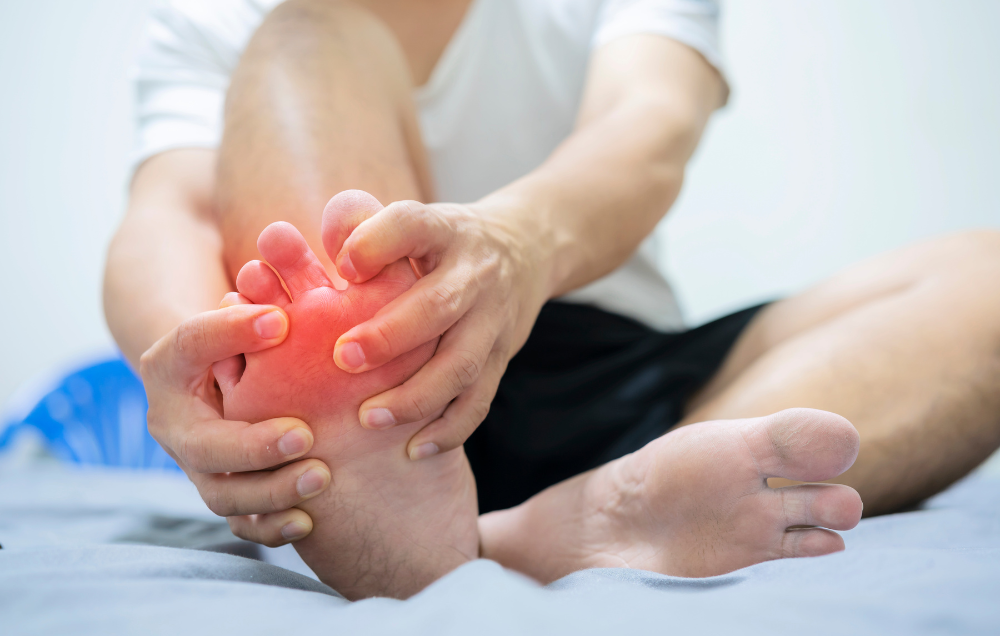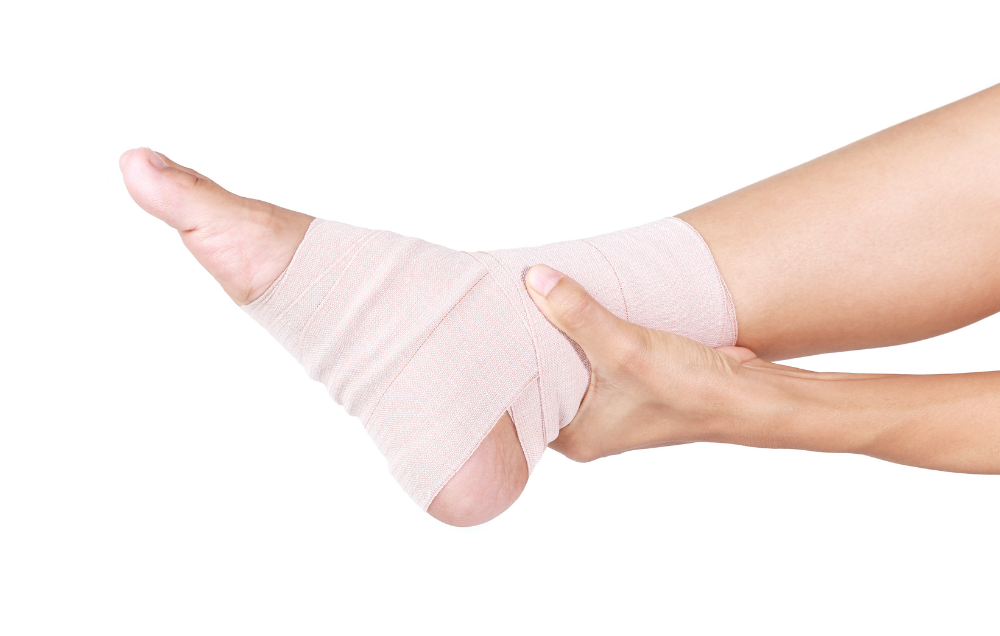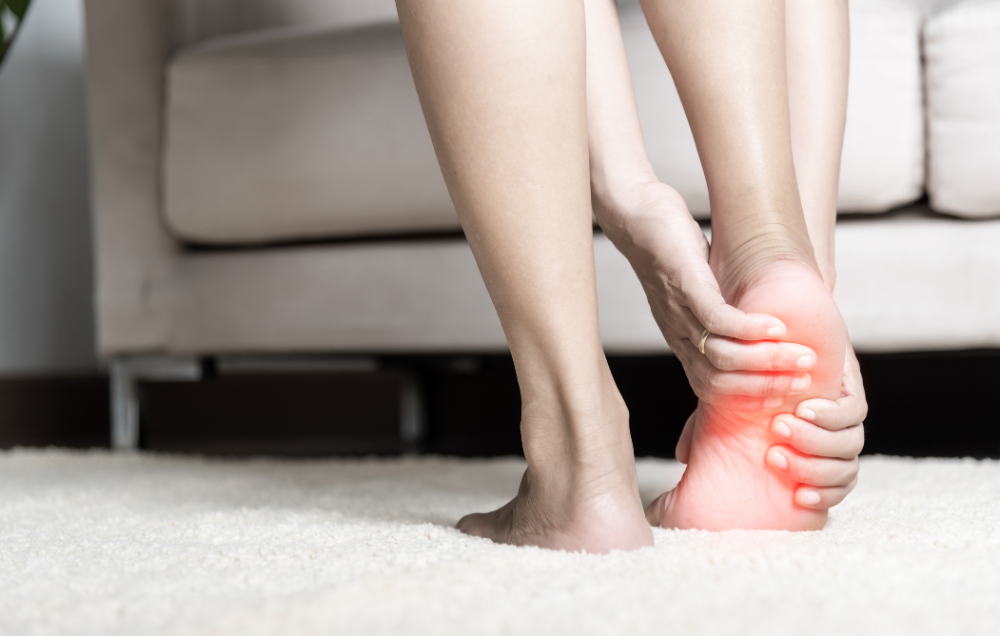Contents
The ankle and foot are complex structures that play a crucial role in supporting the body and enabling movement. They are composed of numerous:
-
- Bones
- Muscles
- Tendons
- Ligaments
These work together to provide:
-
- Stability
- Flexibility
- Balance
The ankle and foot are essential for:
-
- Weight bearing
- Movement
- Balance
- Shock absorption
Injuries to the foot and ankle can significantly impact your mobility and quality of life. Understanding the anatomy of these structures can help you prevent injuries and seek appropriate treatment if necessary.
Possible causes of a swollen foot and ankle
As the foundation of your weight-bearing structure, your feet are subjected to significant pressure and stress on a daily basis. This constant strain can sometimes lead to issues like swelling. Swollen feet and ankles can be a common and uncomfortable problem. They can be caused by a variety of factors, including:
- Injury — Injuries such as sprains, fractures or bruises to the foot or ankle can cause swelling. When you’re injured, your body responds by sending extra blood and fluids to the injured area to support healing and protect the damaged tissue. This increased fluid causes the area to swell as part of the inflammatory response.
- Overuse — Excessive use or stress on the feet and ankles, such as from intense exercise or long periods of standing or walking, can put strain on the muscles and tissue in the feet and ankles. The stress can cause blood vessels to leak fluid into surrounding tissue, resulting in swelling.
- Infections — Infections like cellulitis, a bacterial infection of the skin, or infections from wounds or cuts trigger the body’s immune system to respond. This response sends increased blood flow and white blood cells to the area. This causes inflammation and fluid buildup, leading to:
- Swelling
- Redness
- Warmth
- Pain
- Fluid retention — Factors like consuming too much salt can lead to fluid retention, which is the accumulation of excess fluid in the body’s tissue. The body holds on to this extra fluid, which can pool in the lower extremities, like the feet and ankles, causing swelling.
- Poor circulation — When blood flow is restricted or inefficient, it can cause fluid to accumulate in the feet and ankles. This happens because the heart struggles to pump blood back up from the legs, causing fluid to seep out of the blood vessels into surrounding tissue.
- Heart problems — Conditions like heart failure, where the heart is unable to pump blood effectively, can cause the blood to back up in the veins, especially in the lower limbs. This fluid can leak from the blood vessels into the tissue of the feet and ankles, causing swelling. It can also cause additional symptoms like:
- Shortness of breath
- Fatigue
- Swollen legs
- Kidney problems — The kidneys help remove excess fluid and waste from the bloodstream. When they’re not working well, fluid can build up in the body, causing swelling in various areas, including the feet and ankles. This can be accompanied by symptoms like:
- Changes in urine output
- Fatigue
- Pregnancy — During pregnancy, the body produces extra blood and fluids to support the growing baby. The expanding uterus also puts pressure on the veins in the pelvis, which can affect blood flow and cause fluid to accumulate in the legs and feet. This swelling can be more pronounced in the later stages of pregnancy.
- Certain medications — Some medications can cause fluid retention as a side effect by affecting the balance of the fluids in the body or altering blood vessel function. This can lead to swelling in the feet and ankles.
- Venous insufficiency — When the veins’ valves are damaged or weakened, they can fail to effectively push blood back up to the heart. This causes blood to pool in the veins of the legs, leading to swelling in the feet and ankles.
- Lymphedema — The lymphatic system helps drain excess fluid from tissue. When lymph nodes are damaged or removed, lymph fluid can accumulate. This accumulation can cause persistent swelling in the affected area and requires ongoing management.
- Blood clots — A blood clot in a deep vein can obstruct blood flow, causing swelling in the leg or ankle. This is often associated with symptoms such as pain, redness and warmth. Deep vein thrombosis is a serious condition and may lead to complications like a pulmonary embolism if the clot moves to the lungs.
- Hormonal changes — Hormonal changes can affect the balance of fluids in the body and influence how fluid is processed and retained. This can lead to temporary swelling and bloating in the feet and ankles.
- Allergic reactions — Allergic reactions trigger the release of histamines and other chemicals that cause inflammation and fluid accumulation in the tissue. This can lead the affected area to have:
- Localized swelling
- Itching
- Redness
- Chronic conditions — Chronic conditions, like rheumatoid arthritis and lupus, often involve ongoing inflammation, which can lead to fluid retention and swelling in various parts of the body, including the feet and ankles. These conditions may also cause:
- Joint pain
- Stiffness
- High blood pressure — Persistent high blood pressure can damage blood vessels and affect the fluid balance in the body, leading to swelling in the extremities. High blood pressure can also exacerbate other conditions that contribute to swelling.
- Liver disease — The liver plays a crucial role in managing fluid balance and removing toxins. Liver disease can impair these functions, leading to fluid buildup in the abdominal cavity and legs, which causes swelling in the feet and ankles.
The reason for the swelling will be a determining factor in the right approach to manage it. If you’re concerned about the underlying cause of your swelling, you should consult a health care professional for a diagnosis and treatment recommendation.
What to do for a swollen foot and ankle
Swollen feet and ankles can be a painful and uncomfortable experience, which can significantly impact your daily activities. Fortunately, there are several steps you can take to help alleviate swelling and promote healing, including:
- Rest — Whenever possible, elevate your feet above the level of your heart to help reduce swelling. This can be done by resting with your feet propped up on a pillow or using a footrest.
- Cold therapy — Use a cold compress or ice pack wrapped in a towel to help reduce swelling and inflammation.
- Compression — Wear compression stockings to help improve circulation and reduce swelling. Consult with a health care professional to determine the appropriate compression level.
- Fluid management — Limit your salt intake to help prevent fluid retention, and drink plenty of water to avoid dehydration.
- Lifestyle changes — Avoid standing or sitting for long periods of time. Take breaks and move around to help prevent fluid from pooling in your feet and ankles. Maintain a healthy weight. Excess weight can put extra strain on your feet and ankles, contributing to swelling.
- Proper footwear — Proper footwear can help reduce strain on your feet and ankles, promoting better circulation and comfort. Supportive shoes can help manage swelling and prevent further injury.
- Medication — Over-the-counter nonsteroidal anti-inflammatory drugs (NSAIDs) like ibuprofen or aspirin can help reduce inflammation and relieve pain associated with swelling.
- Physical therapy — A physical therapist can help identify and treat underlying conditions that may be contributing to swelling, such as muscle weakness, poor posture or joint dysfunction. They may use techniques such as:
- Therapeutic exercises — Specific exercises can help improve your range of motion and strengthen muscles, which can improve circulation and reduce swelling.
- Manual therapy — Hands-on techniques used by your physical therapist to manipulate the soft tissue and joints can help reduce pain, improve blood flow and help with fluid drainage from the affected area.
- Other modalities — Certain tools and techniques, such as ultrasound or electrical stimulation, can help reduce inflammation and swelling and alleviate pain. Ultrasound waves and electrical pulses can also promote healing.
- Medical attention — Seek medical care if swelling persists or is accompanied by other symptoms such as:
- Pain
- Redness
- Warmth
- Difficulty moving
These tips may provide you with temporary relief, but it’s crucial to address the underlying cause of your swollen foot and ankle. A health care professional can determine the root of the problem and recommend appropriate treatment.
Lattimore Physical Therapy offers expert solutions for swollen feet and ankles
If you’re dealing with a swollen foot and ankle, Lattimore Physical Therapy is here to help. Our expert team provides personalized treatment plans designed to address your specific needs. We incorporate a range of techniques to reduce swelling and promote healing. With over 30 staff members across our clinics with a Certification in Orthopedic Manual Physical Therapy, we have the experience and expertise to guide you through effective treatment. Let us support you on your journey to recovery and help you get back to feeling your best.
Contact our team today for more information or to schedule an initial appointment.



